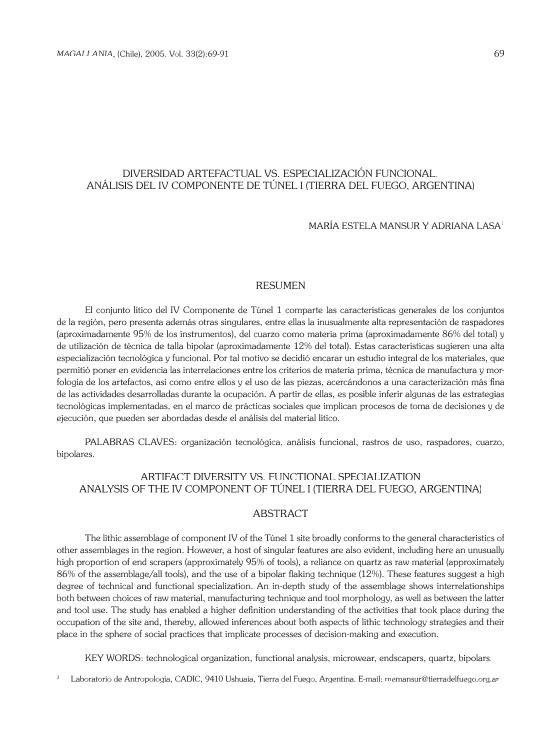Mostrar el registro sencillo del ítem
dc.contributor.author
Mansur, Maria Estela

dc.contributor.author
Lasa, Adriana Edith

dc.date.available
2022-01-31T13:10:55Z
dc.date.issued
2005-12
dc.identifier.citation
Mansur, Maria Estela; Lasa, Adriana Edith; Diversidad artefactual Vs. especialización funcional: Análisis del IV Componente de Túnel I (Tierra del Fuego. Argentina); Universidad de Magallanes; Magallania; 33; 2; 12-2005; 69-91
dc.identifier.issn
0718-2244
dc.identifier.uri
http://hdl.handle.net/11336/150966
dc.description.abstract
El conjunto lítico del IV Componente de Túnel 1 comparte las características generales de los conjuntos de la región, pero presenta además otras singulares, entre ellas la inusualmente alta representación de raspadores (aproximadamente 95% de los instrumentos), del cuarzo como materia prima (aproximadamente 86% del total) y de utilización de técnica de talla bipolar (aproximadamente 12% del total). Estas características sugieren una alta especialización tecnológica y funcional. Por tal motivo se decidió encarar un estudio integral de los materiales, que permitió poner en evidencia las interrelaciones entre los criterios de materia prima, técnica de manufactura y morfología de los artefactos, así como entre ellos y el uso de las piezas, acercándonos a una caracterización más fina de las actividades desarrolladas durante la ocupación. A partir de ellas, es posible inferir algunas de las estrategias tecnológicas implementadas, en el marco de prácticas sociales que implican procesos de toma de decisiones y de ejecución, que pueden ser abordadas desde el análisis del material lítico.
dc.description.abstract
The lithic assemblage of component IV of the Túnel 1 site broadly conforms to the general characteristics of other assemblages in the region. However, a host of singular features are also evident, including here an unusually high proportion of end scrapers (approximately 95% of tools), a reliance on quartz as raw material (approximately 86% of the assemblage/all tools), and the use of a bipolar flaking technique (12%). These features suggest a high degree of technical and functional specialization. An in-depth study of the assemblage shows interrelationships both between choices of raw material, manufacturing technique and tool morphology, as well as between the latter and tool use. The study has enabled a higher definition understanding of the activities that took place during the occupation of the site and, thereby, allowed inferences about both aspects of lithic technology strategies and their place in the sphere of social practices that implicate processes of decision-making and execution.
dc.format
application/pdf
dc.language.iso
spa
dc.publisher
Universidad de Magallanes
dc.rights
info:eu-repo/semantics/openAccess
dc.rights.uri
https://creativecommons.org/licenses/by-nc-sa/2.5/ar/
dc.subject
Túnel I
dc.subject
Lítico
dc.subject
Análisis Funcional
dc.subject.classification
Otras Historia y Arqueología

dc.subject.classification
Historia y Arqueología

dc.subject.classification
HUMANIDADES

dc.title
Diversidad artefactual Vs. especialización funcional: Análisis del IV Componente de Túnel I (Tierra del Fuego. Argentina)
dc.type
info:eu-repo/semantics/article
dc.type
info:ar-repo/semantics/artículo
dc.type
info:eu-repo/semantics/publishedVersion
dc.date.updated
2022-01-06T15:03:01Z
dc.journal.volume
33
dc.journal.number
2
dc.journal.pagination
69-91
dc.journal.pais
Chile

dc.journal.ciudad
Punta Arenas
dc.description.fil
Fil: Mansur, Maria Estela. Consejo Nacional de Investigaciones Científicas y Técnicas. Centro Austral de Investigaciones Científicas; Argentina
dc.description.fil
Fil: Lasa, Adriana Edith. Consejo Nacional de Investigaciones Científicas y Técnicas. Centro Austral de Investigaciones Científicas; Argentina
dc.journal.title
Magallania
dc.relation.alternativeid
info:eu-repo/semantics/altIdentifier/url/https://www.scielo.cl/scielo.php?script=sci_abstract&pid=S0718-22442005000200006&lng=en&nrm=i&tlng=es
Archivos asociados
